Air Quality and Comfort Characterisation within an Electric Vehicle Cabin in Heating and Cooling Operations †
Abstract
:1. Introduction
2. Materials and Methods
2.1. Description of the Experimental Setup
2.2. Description of the Arduino-Based System of Sensors
3. Results and Discussion
3.1. Measurements during Heating Operation
3.1.1. Fresh-Air Configuration
3.1.2. Recirculation Configuration
3.1.3. Comparison between Fresh-Air and Recirculation Mode in Winter
3.2. Measurements during Cooling Operation
3.2.1. Fresh-Air Configuration
3.2.2. Recirculation Configuration
3.2.3. Comparison between Fresh-Air and Recirculation Modes in Summer
3.3. Effect of Filter Conditions on Filtration Performance
4. Conclusions
Supplementary Materials
Author Contributions
Funding
Institutional Review Board Statement
Informed Consent Statement
Data Availability Statement
Acknowledgments
Conflicts of Interest
Abbreviations
| BEV | Battery Electric Vehicle |
| HVAC | Heating, Ventilation and Air Conditioning |
| A/C | Air Conditioning |
| PTC | Positive Temperature Coefficient |
| IAQ | Internal Air Quality |
| OBD | On-Board Diagnostic |
| MY | Model Year |
| I/O | Inside/Outside |
| NTC | Negative Temperature Coefficient |
| PM | Particulate Matter |
| VOC | Volatile Organic Compounds |
References
- Optemus—Optemus|Optimised and Systematic Energy Management in Electric Vehicles. Available online: http://www.optemus.eu/ (accessed on 24 December 2021).
- BS ISO/DIS 14505-4:2020; Ergonomics of the Thermal Environment—Evaluation of Thermal Environments in Vehicles—Part 4: Determination of the Equivalent Temperature by Means of a Numerical Manikin. BSI Standards Publication: London, UK, 2020.
- Nilsson, H. Comfort Climate Evaluation with Thermal Manikin Methods and Computer Simulation Models. Ph.D. Thesis, Byggvetenskap, Stockholm, Sweden, 2004. [Google Scholar]
- Zhang, C.; Shen, K.; Yang, F.; Yuan, C. Multiphysics Modeling of Energy Intensity and Energy Efficiency of Electric Vehicle Operation. Procedia CIRP 2019, 80, 322–327. [Google Scholar] [CrossRef]
- World Health Organization (Ed.) WHO Guidelines for Indoor Air Quality: Household Fuel Combustion; World Health Organization: Geneva, Switzerland, 2014. [Google Scholar]
- WHO. Who Guidelines for Indoor Air Quality: Selected Pollutants; WHO: Copenhagen, Denmark, 2010. [Google Scholar]
- Heseltine, E.; Rosen, J.; World Health Organization (Eds.) WHO Guidelines for Indoor Air Quality: Dampness and Mould; WHO: Copenhagen, Denmark, 2009. [Google Scholar]
- Settimo, G.; Manigrasso, M.; Avino, P. Indoor Air Quality: A Focus on the European Legislation and State-of-the-Art Research in Italy. Atmosphere 2020, 11, 370. [Google Scholar] [CrossRef] [Green Version]
- Heo, K.J.; Noh, J.W.; Lee, B.U.; Kim, Y.; Jung, J.H. Comparison of filtration performance of commercially available automotive cabin air filters against various airborne pollutants. Build. Environ. 2019, 161, 106272. [Google Scholar] [CrossRef]
- Atkinson, W.J.; Hill, W.R.; Mathur, G.D. The Impact of Increased Air Recirculation on Interior Cabin Air Quality; SAE Technical Paper; SAE International: Warrendale, PA, USA, 2017. [Google Scholar] [CrossRef]
- Vartires, A.; Colda, I.; Toropoc, S.M. Research on thermal comfort and indoor air pollution in a passenger car. In Proceedings of the 2017 International Conference on ENERGY and ENVIRONMENT (CIEM), Bucharest, Romania, 19–20 October 2017; pp. 148–152. [Google Scholar] [CrossRef]
- Pham, L.; Molden, N.; Boyle, S.; Johnson, K.; Jung, H. Development of a Standard Testing Method for Vehicle Cabin Air Quality Index. SAE Int. J. Commer. Veh. 2019, 12, 151–161. [Google Scholar] [CrossRef] [Green Version]
- Grady, M.L.; Jung, H.; Chul Kim, Y.; Park, J.K.; Lee, B.C. Vehicle Cabin Air Quality with Fractional Air Recirculation. In Proceedings of the SAE 2013 World Congress & Exhibition, Detroit, MI, USA, 16–18 April 2013; SAE: Warrendale, PA, USA, 2013. [Google Scholar] [CrossRef] [Green Version]
- Alger, J.A.; Buss, A.R.; Creasman, J.D.; Hoy, J.R. Automatic Vehicle Climate Control Based on Predicted Air Quality. U.S. Patent US10226982B2, 12 March 2019. [Google Scholar]
- Newman, A. Automatic Vehicle Cabin Air Filtration System. U.S. Patent US10245924B2, 2 April 2019. [Google Scholar]
- Li, C.; Brewer, E.; Pham, L.; Jung, H. Reducing Mobile Air Conditioner (MAC) Power Consumption Using Active Cabin-Air-Recirculation in A Plug-In Hybrid Electric Vehicle (PHEV). World Electr. Veh. J. 2018, 9, 51. [Google Scholar] [CrossRef] [Green Version]
- Gerboles, M.; Spinelle, L.; Borowiak, A. Measuring Air Pollution with Low-Cost Sensors. Available online: https://ec.europa.eu/jrc/en/publication/brochures-leaflets/measuring-air-pollution-low-cost-sensors (accessed on 5 March 2021).
- Rüffer, D.; Hoehne, F.; Bühler, J. New Digital Metal-Oxide (MOx) Sensor Platform. Sensors 2018, 18, 1052. [Google Scholar] [CrossRef] [PubMed] [Green Version]
- Yasuda, T.; Yonemura, S.; Tani, A. Comparison of the Characteristics of Small Commercial NDIR CO2 Sensor Models and Development of a Portable CO2 Measurement Device. Sensors 2012, 12, 3641–3655. [Google Scholar] [CrossRef] [PubMed] [Green Version]
- Tryner, J.; Mehaffy, J.; Miller-Lionberg, D.; Volckens, J. Effects of aerosol type and simulated aging on performance of low-cost PM sensors. J. Aerosol Sci. 2020, 150, 105654. [Google Scholar] [CrossRef]
- Russi, L.; Guidorzi, P.; Pulvirenti, B.; Semprini, G.; Aguiari, D.; Pau, G. Air quality and comfort characterisation within an electric vehicle cabin. In Proceedings of the 2021 IEEE International Workshop on Metrology for Automotive (MetroAutomotive), Bologna, Italy, 1–2 July 2021; pp. 169–174. [Google Scholar] [CrossRef]
- Kondaveeti, H.K.; Kumaravelu, N.K.; Vanambathina, S.D.; Mathe, S.E.; Vappangi, S. A systematic literature review on prototyping with Arduino: Applications, challenges, advantages, and limitations. Comput. Sci. Rev. 2021, 40, 100364. [Google Scholar] [CrossRef]
- Karami, M.; McMorrow, G.V.; Wang, L. Continuous monitoring of indoor environmental quality using an Arduino-based data acquisition system. J. Build. Eng. 2018, 19, 412–419. [Google Scholar] [CrossRef]
- Kumar Sai, K.B.; Mukherjee, S.; Parveen Sultana, H. Low Cost IoT Based Air Quality Monitoring Setup Using Arduino and MQ Series Sensors With Dataset Analysis. Procedia Comput. Sci. 2019, 165, 322–327. [Google Scholar] [CrossRef]
- Doyle, A.; Muneer, T. Energy consumption and modelling of the climate control system in the electric vehicle. Energy Explor. Exploit. 2019, 37, 519–543. [Google Scholar] [CrossRef] [Green Version]
- Doyle, A.; Muneer, T.; Smith, I. A review of the thermal performance of electric vehicles. In Proceedings of the 2015 IEEE International Transportation Electrification Conference (ITEC), Chennai, India, 27–29 August 2015; pp. 1–5. [Google Scholar] [CrossRef]
- Koritsoglou, K.; Christou, V.; Ntritsos, G.; Tsoumanis, G.; Tsipouras, M.G.; Giannakeas, N.; Tzallas, A.T. Improving the Accuracy of Low-Cost Sensor Measurements for Freezer Automation. Sensors 2020, 20, 6389. [Google Scholar] [CrossRef] [PubMed]
- BS ISO 16000-37:2019; Indoor Air—Part 37: Measurement of PM2.5 Mass Concentration. BSI Standards Publication: London, UK, 2019.
- BS ISO 12219-1:2012; Interior Air of Road Vehicles—Part 1: Whole Vehicle Test Chamber—Specification and Method for the Determination of Volatile Organic Compounds in Cabin Interiors. BSI Standards Publication: London, UK, 2012.
- Aguiari, D. Exploring Computing Continuum in IoT Systems: Sensing, Communicating and Processing at the Network Edge. Ph.D. Thesis, University of Cagliari—Sorbonne Université, Cagliari, Italy, 2021. Cap. 7. [Google Scholar]
- Christ, R.D.; Wernli, R.L. Sensor Theory. In The ROV Manual; Elsevier: Amsterdam, The Netherlands, 2014; pp. 297–326. [Google Scholar] [CrossRef]
- Guthrie, W.F. NIST/SEMATECH e-Handbook of Statistical Methods (NIST Handbook 151). Available online: https://www.itl.nist.gov/div898/handbook/ (accessed on 18 March 2021). [CrossRef]
- Guidelines for Reliable Long Line 1-Wire Networks. Available online: https://www.maximintegrated.com/en/design/technical-documents/tutorials/1/148.html (accessed on 14 October 2021).
- Bosch Sensortec BME280 Combined Humidity and Pressure Sensor. Available online: https://www.bosch-sensortec.com/products/environmental-sensors/humidity-sensors-bme280/ (accessed on 8 November 2021).
- Li, J.; Li, H.; Ma, Y.; Wang, Y.; Abokifa, A.A.; Lu, C.; Biswas, P. Spatiotemporal distribution of indoor particulate matter concentration with a low-cost sensor network. Build. Environ. 2018, 127, 138–147. [Google Scholar] [CrossRef]
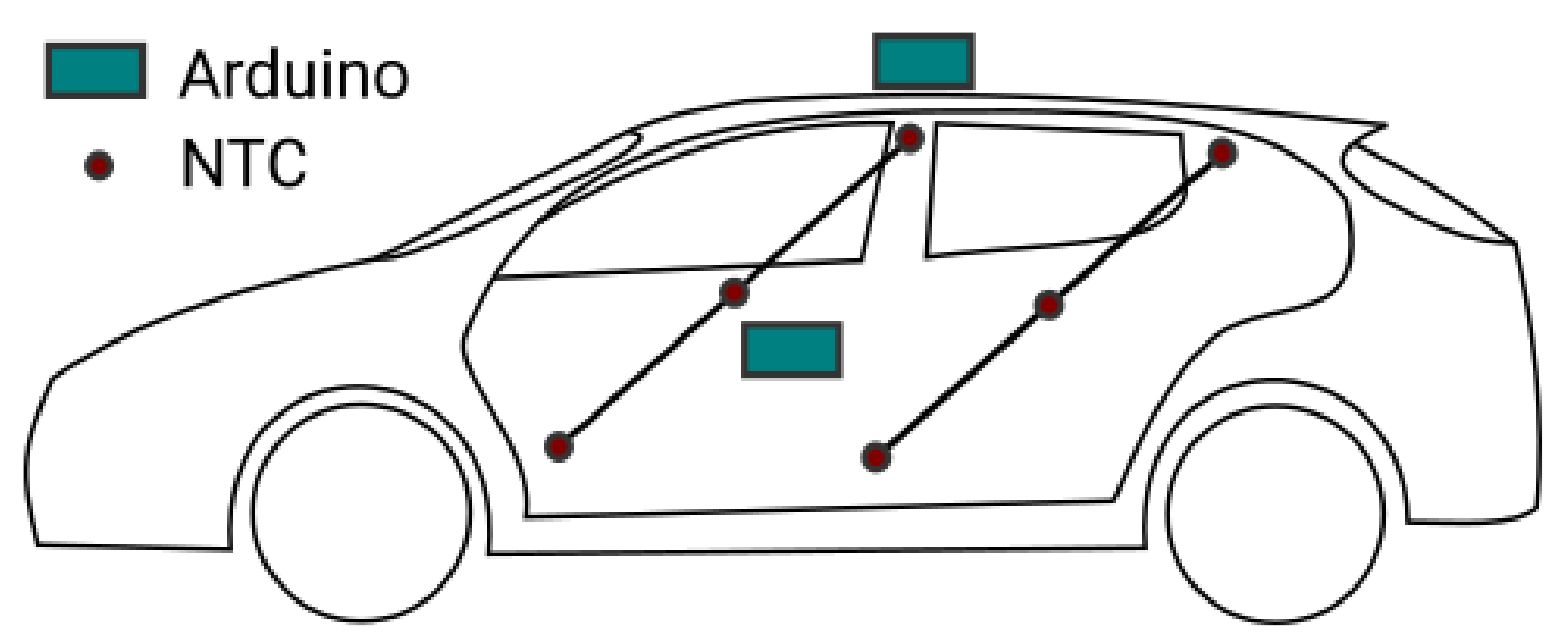


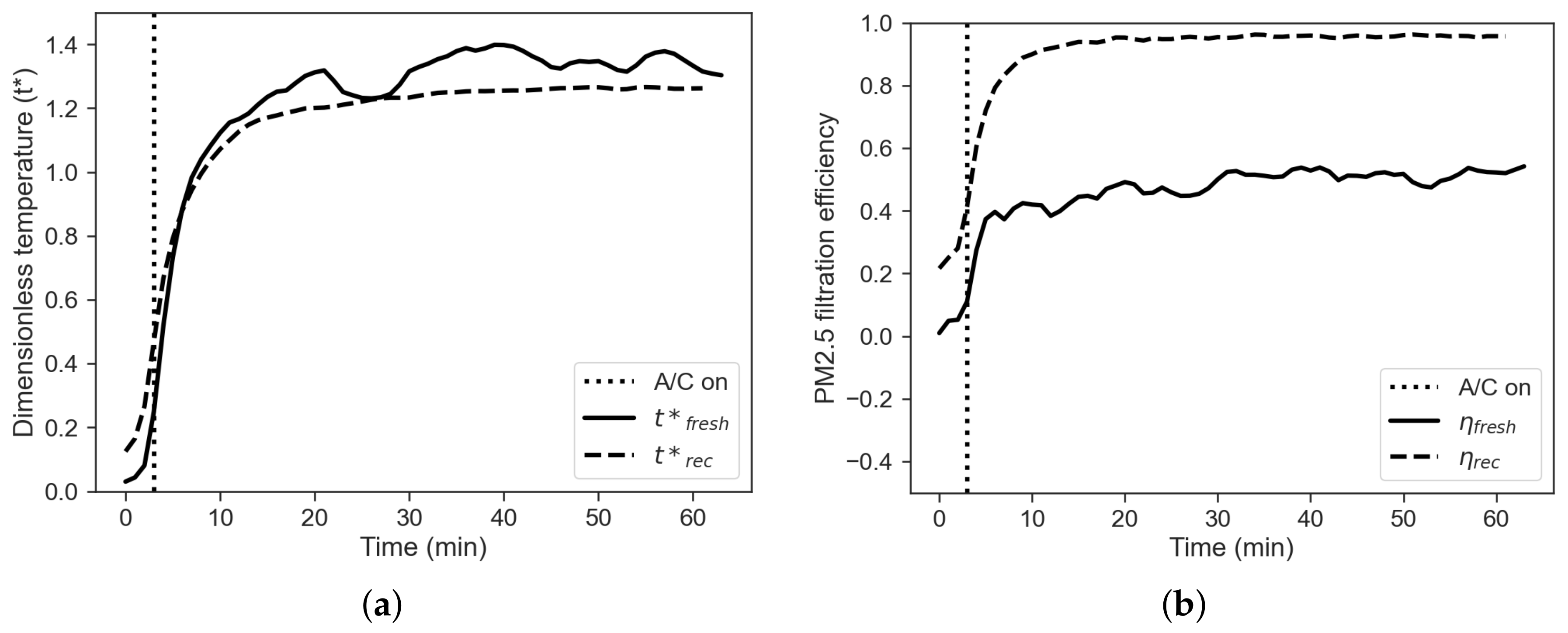
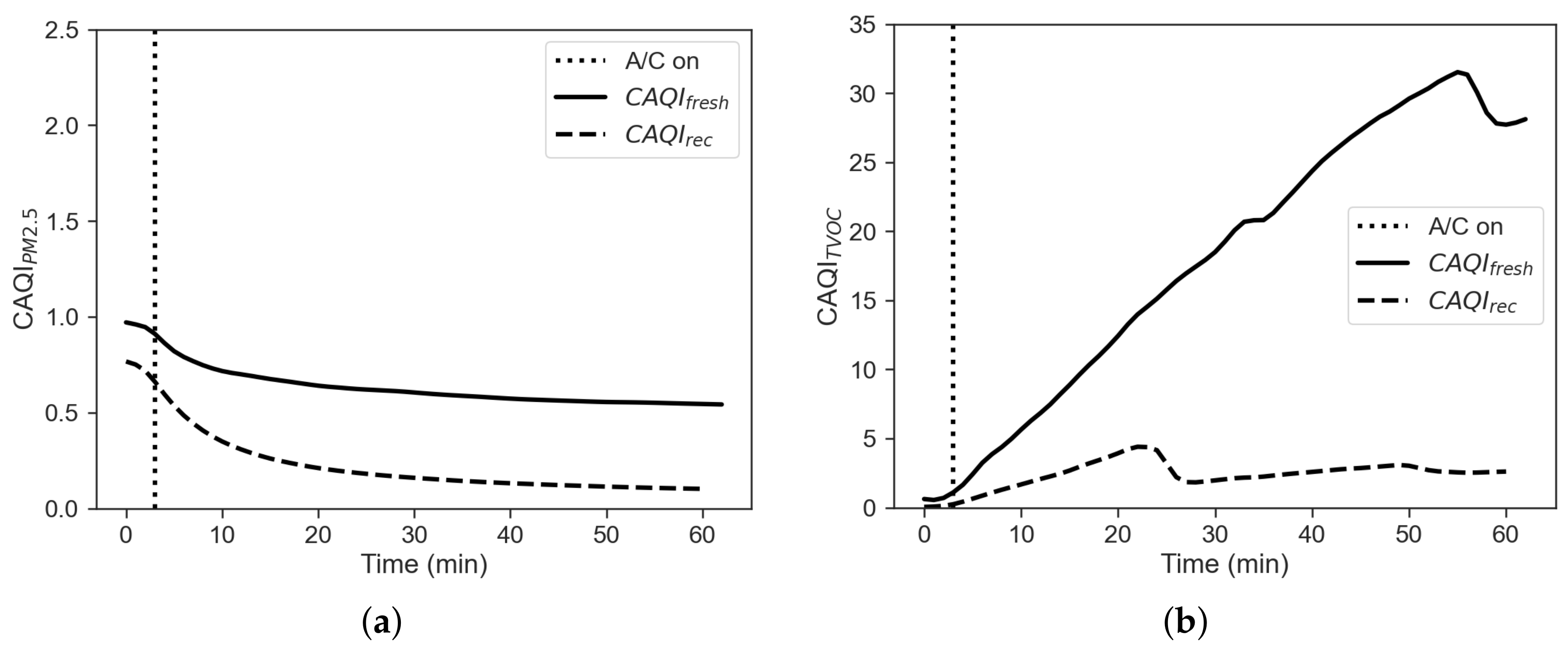
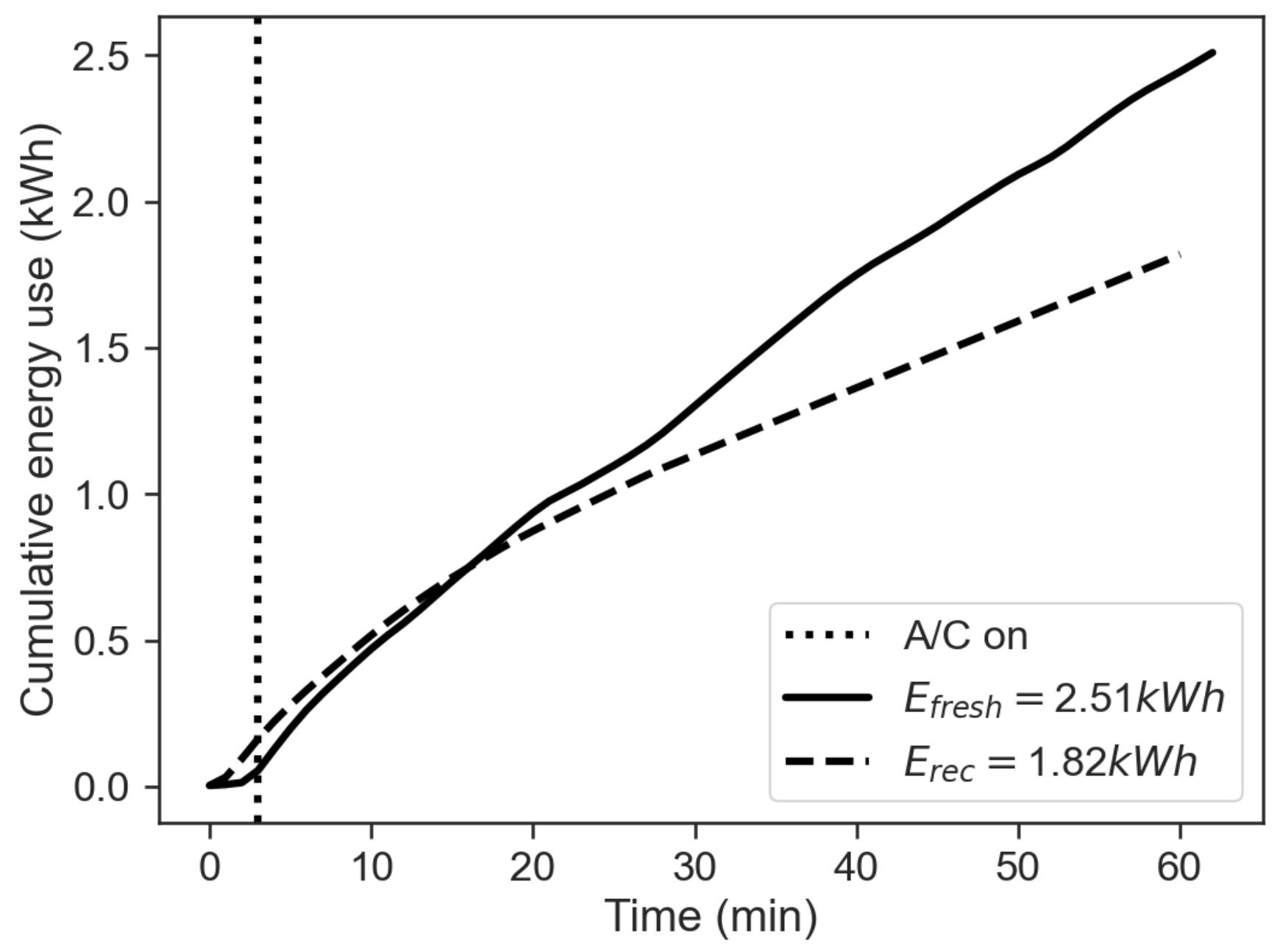


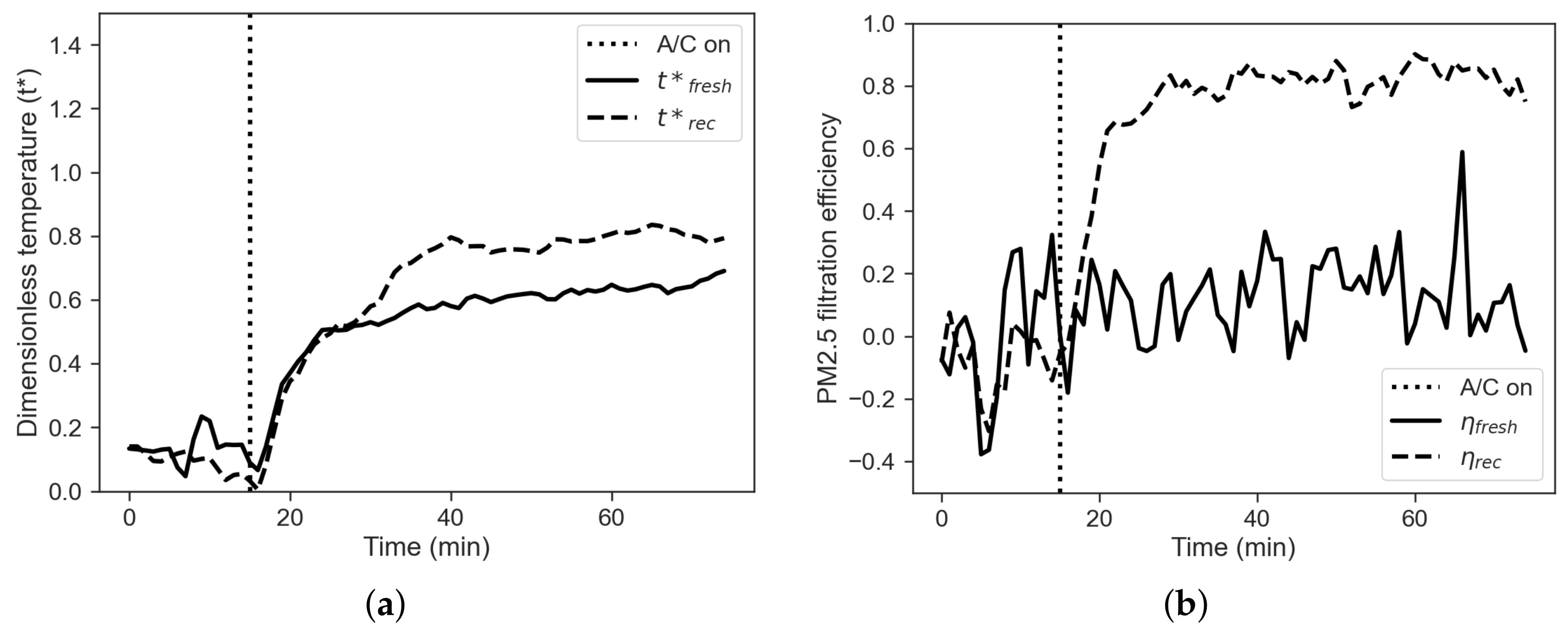
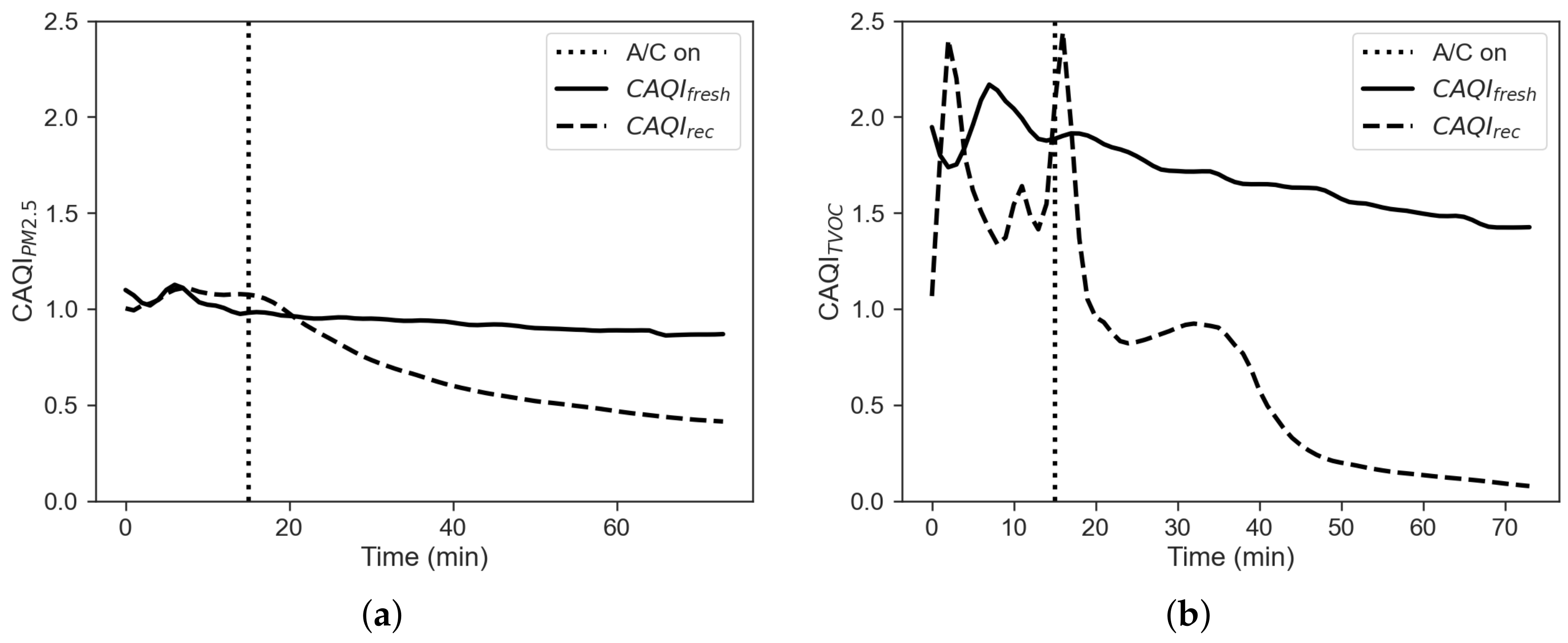


| Variable (Unit) | Sensors Specifications | |||
|---|---|---|---|---|
| Description | Manufacturer | Model | Accuracy (Offset + Gain) | |
| ta(°C) | Air temp. | Maxim Integrated | DS18B20 | ±(0.5 °C + 1% mv ) |
| Air rel. hum. | Bosch | BME280 | ||
| Air pres. | Bosch | BME280 | ||
| TVOC conc. | Sensirion | SGP30 | ±(15% mv) | |
| (g/m) | PM2.5 conc. | Sensirion | SPS30 | ±(10 g/m + 10% mv) |
| Subsystem i power usage | iWave | OBD/Linux | ||
Publisher’s Note: MDPI stays neutral with regard to jurisdictional claims in published maps and institutional affiliations. |
© 2022 by the authors. Licensee MDPI, Basel, Switzerland. This article is an open access article distributed under the terms and conditions of the Creative Commons Attribution (CC BY) license (https://creativecommons.org/licenses/by/4.0/).
Share and Cite
Russi, L.; Guidorzi, P.; Pulvirenti, B.; Aguiari, D.; Pau, G.; Semprini, G. Air Quality and Comfort Characterisation within an Electric Vehicle Cabin in Heating and Cooling Operations. Sensors 2022, 22, 543. https://doi.org/10.3390/s22020543
Russi L, Guidorzi P, Pulvirenti B, Aguiari D, Pau G, Semprini G. Air Quality and Comfort Characterisation within an Electric Vehicle Cabin in Heating and Cooling Operations. Sensors. 2022; 22(2):543. https://doi.org/10.3390/s22020543
Chicago/Turabian StyleRussi, Luigi, Paolo Guidorzi, Beatrice Pulvirenti, Davide Aguiari, Giovanni Pau, and Giovanni Semprini. 2022. "Air Quality and Comfort Characterisation within an Electric Vehicle Cabin in Heating and Cooling Operations" Sensors 22, no. 2: 543. https://doi.org/10.3390/s22020543
APA StyleRussi, L., Guidorzi, P., Pulvirenti, B., Aguiari, D., Pau, G., & Semprini, G. (2022). Air Quality and Comfort Characterisation within an Electric Vehicle Cabin in Heating and Cooling Operations. Sensors, 22(2), 543. https://doi.org/10.3390/s22020543









